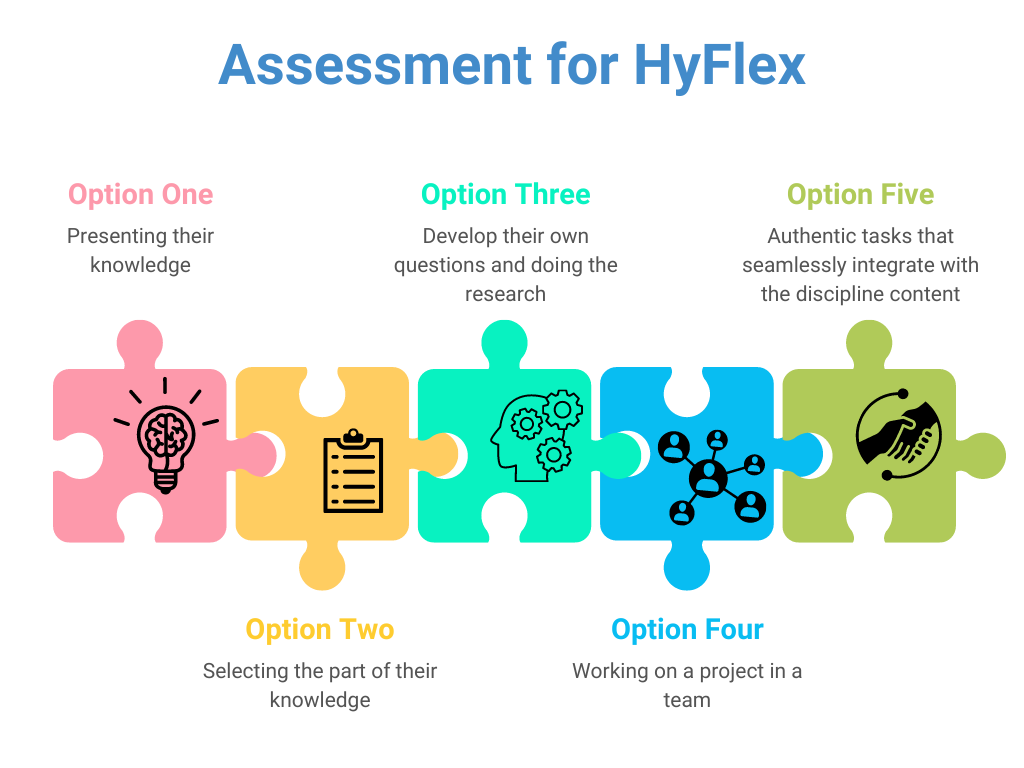Assessment
Flexible Assessment
Here are some examples of how you can make assessment flexible. Offering more than one option builds into that student’s choice.

Presenting their knowledge
Give multiple options about how the students will show you what they know. Include opportunities for students to use some of the skills they have. Someone who is good at essay writing is very privileged when all of the assessment is writing essays. Someone who is good at making videos would be equally privileged if all the assessments were video presentations. Allow the student to choose the best support for them to achieve at the highest level. Creating a digital artefact (with a choice of tool) encourages transliteracy skills and clear communication of ideas through the use of multimedia.
Selecting the part of their knowledge
Allow and encourage students to pick from a range of questions/topics. Well-designed assessment tasks should be able to provide multiple options without losing any equivalence in the demonstration of learning. A good rubric and clear criteria provide a scaffold for a marker-to-grade assessment that may look a little different to each other.
Develop their own questions and doing the research
The learner can be given the opportunity to be a researcher and not just a presenter of their knowledge. Supporting the learner to investigate an area of interest within the guidelines for the course will support their skill development in inquiry as well as their motivation.
Working on a project in a team
Group work is rarely popular; however, it allows learners to acquire new skills in communication, collaboration and co-creation. These are especially vital when working virtually. One approach is to require some co-created work, such as a website, in conjunction with individual work, such as a multimedia artefact to embed on the website or a personal reflection (or both!).
For team projects, the following checklist will help:
- How will students communicate online? (provide the facility or leave it up to them? Do you need evidence of communication? Is this evidence part of the assessment?)
- Where will they store planning notes and ideas? (do you need to see process or final product, or both?)
- Where will the final collaborative product be available? (presumably online?)
- Will the final product be visible to other students?
Beatty (2024) provides tips for HyFlex group work and states:
The largest difference may be that dedicating class time for group discussion and process time may not be as effective with “mixed-mode” groups since some students may not be present in the synchronous session.
Authentic tasks that seamlessly integrate with the discipline content
Authentic tasks are relevant to the learner and highly motivating. This includes encouraging the learner to connect with professionals in their field and draw on their knowledge. Good learning design will weave the authentic task into the actual learning of the content so that the learner may not be aware of the learning or the assessment.
Although students may find working with digital media challenging, if scaffolding and choice are provided, the experience can build confidence in online tools and mastery of creating communication pieces.
References
Beatty, B.J. (2024, July 30). Guidelines for Group Projects in a HyFlex Course. https://www.hyflexlearning.org/2024/07/30/guidelines-for-group-projects/
Media Attributions
- Assessment for HyFlex © Lisa Jacka is licensed under a CC BY-NC (Attribution NonCommercial) license

